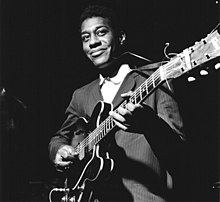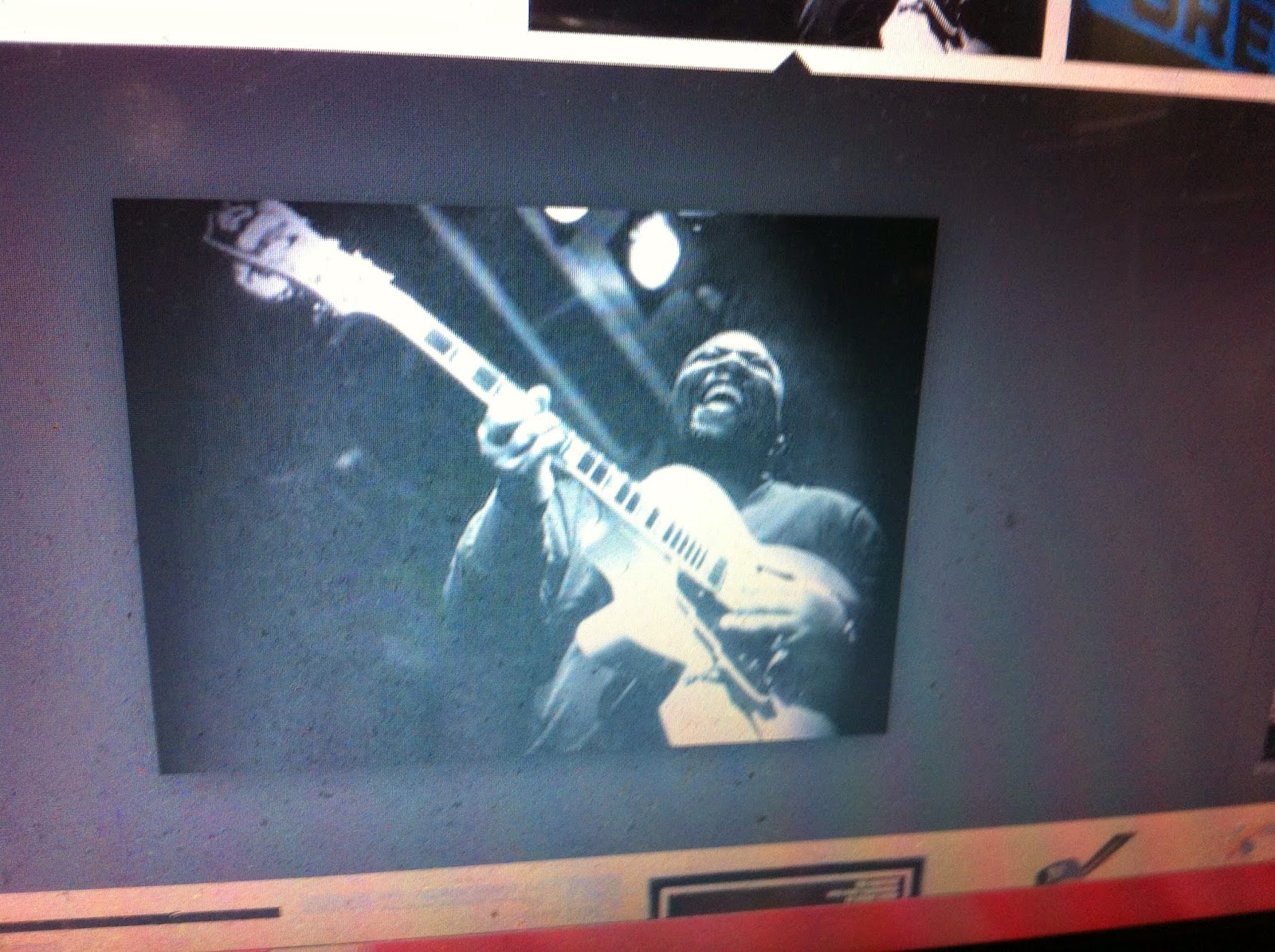BLACK SOCIAL HISTORY Grant Green
.
| Grant Green | |
|---|---|
 | |
| Background information | |
| Born | June 6, 1935 |
| Died | January 31, 1979 (aged 43) |
| Genres | Soul jazz, hard bop, jazz blues, post-bop, jazz-funk |
| Occupation(s) | Musician, songwriter |
| Instruments | Guitar |
| Years active | 1959–1978 |
| Labels | Blue Note Records |
| Associated acts | Larry Young, Lou Donaldson,Big John Patton |
| Notable instruments | |
| Gibson ES-330, D'Aquisto | |
Grant Green (June 6, 1935 – January 31, 1979; some sources erroneously give his year of birth as 1931[1]) was an American jazz guitarist and composer.
Recording prolifically and mainly for Blue Note Records (as both leader and sideman) Green performed in the hard bop, soul jazz,bebop and Latin-tinged idioms throughout his career. Critics Michael Erlewine and Ron Wynn write, "A severely underrated player during his lifetime, Grant Green is one of the great unsung heroes of jazz guitar ... Green's playing is immediately recognizable – perhaps more than any other guitarist."[2] Critic Dave Hunter described his sound as "lithe, loose, slightly bluesy and righteously groovy".[3] He often performed in an organ trio, a small group with an organ and drummer.
Apart from guitarist Charlie Christian, Green's primary influences were saxophonists, particularly Charlie Parker, and his approach was therefore almost exclusively linear rather than chordal. The simplicity and immediacy of Green's playing, which tended to avoid chromaticism, derived from his early work playing rhythm and blues and, although at his best he achieved a synthesis of this style with bop, he was essentially a blues guitarist and returned almost exclusively to this style in his later career.[4]
Biography
Green was born in St. Louis, Missouri. He first performed in a professional setting at the age of 12. His influences were Charlie Christian, Charlie Parker, Lester Young, and Jimmy Raney, he first played boogie-woogie before moving on to jazz. His first recordings in St. Louis were with tenor saxophonist Jimmy Forrest for the United label. The drummer in the band was Elvin Jones, later the powerhouse behind John Coltrane. Grant recorded with Elvin again in the early 1960s. Lou Donaldson discovered Grant playing in a bar in St. Louis. After touring together with Donaldson, Grant arrived in New York around 1959–60.
Lou Donaldson introduced Grant to Alfred Lion of Blue Note Records. Lion was so impressed with Grant that rather than testing Grant as a sideman, as was the usual Blue Note practice, Lion arranged for him to record as a group leader first. However, due to a lack of confidence on Green's part the initial recording session was only released in 2001 asFirst Session.[5][6]
Despite the shelving of his first session, Green's recording relationship with Blue Note was to last, with a few exceptions, throughout the Sixties. From 1961 to 1965, Grant made more appearances on Blue Note LPs, as leader or sideman, than anyone else. Grant's first issued album as a leader was Grant's First Stand. This was followed in the same year by Green Street and Grantstand. Grant was named best new star in the Down Beat critics' poll, in 1962. He often provided support to the other important musicians on Blue Note, including saxophonists Hank Mobley, Ike Quebec, Stanley Turrentine and organist Larry Young.
Sunday Mornin' , The Latin Bit and Feelin' the Spirit are all loose concept albums, each taking a musical theme or style: Gospel, Latin and spirituals respectively. Grant always carried off his more commercial dates with artistic success during this period. Idle Moments (1963), featuring Joe Henderson and Bobby Hutcherson, and Solid (1964), are thought of as two of Grant's best recordings.
Many of Grant's recordings were not released during his lifetime. These include McCoy Tyner and Elvin Jones (also part of the Solid group) performing on Matador (also recorded in 1964), and several albums with pianist Sonny Clark. In 1966 Grant left Blue Note and recorded for several other labels, including Verve. From 1967 to 1969 Grant was, for the most part, inactive due to personal problems and the effects of heroin addiction. In 1969 Grant returned with a new funk-influenced band. His recordings from this period include the commercially successful Green is Beautiful and the soundtrack to the film The Final Comedown.
Grant left Blue Note again in 1974 and the subsequent recordings he made with other labels divide opinion: some consider Green to have been the 'Father of Acid Jazz' (and his late recordings have been sampled by artists including US3, A Tribe Called Quest and Public Enemy),[7] while others have dismissed them (reissue producer Michael Cuscunawrote in the sleeve notes for the album Matador: "During the 1970s [Green] made some pretty lame records").
Grant spent much of 1978 in hospital and, against the advice of doctors, went back on the road to earn some money. While in New York to play an engagement at George Benson's Breezin' Lounge, Grant collapsed in his car of a heart attack in New York City on January 31, 1979. He was buried in Greenwood Cemetery in his hometown of St. Louis, Missouri, and was survived by six children. Since Green's demise, his reputation has grown and many compilations of both his earlier (post-bop/straight ahead and soul jazz) and later (funkier/dancefloor jazz) periods, exist.
Equipment
Green used a Gibson ES-330, then a Gibson L7 with a Gibson McCarty pickguard/pick-up, an Epiphone Emperor (with the same pick-up) and finally had a custom-built D'Aquisto. According to fellow guitarist George Benson, Grant achieved his tone by turning off the bass and treble settings of his amplifier, and maximizing the midrange. This way he could get his signature punchy, biting tone.
Discography
As leader
- Blue Note Records
| Recording Date | Title | Release Date |
|---|---|---|
| 1960-61 | First Session | 2001 |
| 1961 | Grant's First Stand | 1961 |
| 1961 | Green Street | 1961 |
| 1961 | Sunday Mornin' | 1961 |
| 1961 | Grantstand | 1961 |
| 1961 | Remembering | 1980 |
| 1961 | Gooden's Corner | 1980 |
| 1962 | Nigeria | 1980 |
| 1962 | Oleo | 1980 |
| 1962 | Born to Be Blue | 1985 |
| 1962 | The Latin Bit | 1962 |
| 1962 | Goin' West | 1969 |
| 1962 | Feelin' the Spirit | 1962 |
| 1963 | Blues for Lou | 1999 |
| 1963 | Am I Blue | 1963 |
| 1963 | Idle Moments | 1964 |
| 1964 | Matador | 1979 |
| 1964 | Solid | 1979 |
| 1964 | Talkin' About! | 1964 |
| 1964 | Street of Dreams | 1964 |
| 1965 | I Want to Hold Your Hand | 1965 |
| 1969 | Carryin' On | 1969 |
| 1970 | Green Is Beautiful | 1970 |
| 1970 | Alive! | 1970 |
| 1971 | Live at Club Mozambique | 2006 |
| 1971 | Visions | 1971 |
| 1971 | Shades of Green | 1971 |
| 1971 | The Final Comedown | 1972 |
| 1972 | Live at The Lighthouse | 1972 |
- Other labels
| Recording Date | Title | Label | Release Date | Notes |
|---|---|---|---|---|
| 1961 | Reaching Out | Black Lion Records[8] | 1961 | Originally released in 1961 as Dave Bailey Quintet, Reaching Out (Jazztime JT-003). Reissued in 1973 as Grant Green, Green Blues (Muse Records-MR 5014) 1973. Reissued in 1989 as Grant Green, Reaching Out (Black Lion Records-BLCD760129). |
| 1965 | His Majesty King Funk | Verve | 1965 | |
| 1967 | Iron City | Cobblestone | 1972 | |
| 1976 | The Main Attraction | Kudu | 1976 | |
| 1978 | Easy | Versatile | 1978 |
As sideman
1959
- Jimmy Forrest – All the Gin Is Gone (Delmark)
- Jimmy Forrest – Black Forrest (Delmark)
1960
- Sam Lazar – Space Flight (Argo)
- Willie Dixon – Blues Roots Series, Vol. 12 (Chess)
1961
- Lou Donaldson – Here 'Tis (Blue Note)
- Baby Face Willette – Face to Face (Blue Note)
- Baby Face Willette – Stop and Listen (Blue Note)
- Brother Jack McDuff – The Honeydripper (Prestige)
- Stanley Turrentine – Up at "Minton's" (Blue Note)
- Dave Bailey – Reaching Out (Jazztime)
- Hank Mobley – Workout (Blue Note)
- Horace Parlan – Up & Down (Blue Note)
- Brother Jack McDuff – Steppin' Out (Prestige)
- Brother Jack McDuff – Goodnight, It's Time to Go (Prestige)
- Stanley Turrentine – ZT's Blues (Blue Note)
- Lou Donaldson – A Man with a Horn (Blue Note)
- Sonny Red – The Mode (Jazzland)
- Sonny Red – Images (Jazzland)
- Ike Quebec – Blue & Sentimental (Blue Note)
1962
- Joe Carroll – Man with a Happy Sound (Charlie Parker Records)
- Dodo Greene – My Hour of Need (Blue Note)
- Don Wilkerson – Elder Don (Blue Note)
- Lou Donaldson – The Natural Soul (Blue Note)
- Don Wilkerson – Preach Brother! (Blue Note)
1963
- Lou Donaldson – Good Gracious! (Blue Note)
- Jimmy Smith – I'm Movin' On (Blue Note)
- Jimmy Smith – Special Guests (Blue Note Japan)
- Booker Ervin – Back from the Gig (Blue Note)
- Herbie Hancock – My Point of View (Blue Note)
- Horace Parlan – Happy Frame of Mind (Blue Note)
- "Big" John Patton – Along Came John (Blue Note)
- Gloria Coleman – Soul Sisters (Impulse!)
- Harold Vick – Steppin' Out! (Blue Note)
- "Big" John Patton – Blue John (Blue Note)
- Don Wilkerson – Shoutin' (Blue Note)
- George Braith – Two Souls in One (Blue Note)
- Mary Lou Williams – Black Christ of the Andes (Saba/MPS)
- George Braith – Soulstream (Blue Note)
- Bobby Hutcherson – The Kicker (Blue Note)
1964
- Lee Morgan – Search for the New Land (Blue Note)
- George Braith – Extension (Blue Note)
- "Big" John Patton – The Way I Feel (Blue Note)
- Larry Young – Into Somethin' (Blue Note)
- Donald Byrd – I'm Tryin' to Get Home (Blue Note)
1965
- Johnny Hodges/Wild Bill Davis – Joe's Blues (Verve)
- Grassella Oliphant – The Grass Is Greener (Atlantic)
- "Big" John Patton – Oh Baby! (Blue Note)
- Art Blakey – Hold On, I'm Coming (Limelight)
- Lou Donaldson – Musty Rusty (Cadet)
- Johnny Hodges/Wild Bill Davis – Wings and Things (Verve)
- "Big" John Patton – Let 'em Roll (Blue Note)
1966
- George Braith – Laughing Soul (Prestige)
- "Big" John Patton – Got a Good Thing Goin' (Blue Note)
- Art Blakey – Hold On, I'm Coming (Limelight)
- Stanley Turrentine – Rough 'n' Tumble (Blue Note)
1969
- Rusty Bryant – Rusty Bryant Returns (Prestige)
- Charles Kynard – The Soul Brotherhood (Prestige)
- Reuben Wilson – Love Bug (Blue Note)
- Don Patterson – Brothers-4 (Prestige)
- Don Patterson – Donny Brook (Prestige)
- Don Patterson – Tune Up! (Prestige)
1970
- Charles Kynard – Afro-Disiac (Prestige)
- Fats Theus – Black Out (CTI)
- Houston Person – Person to Person! (Prestige)
1973
- Houston Person – The Real Thing (Eastbound)











































































































































No comments:
Post a Comment